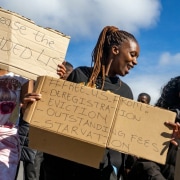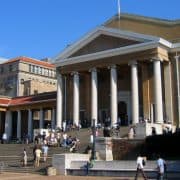|
Getting your Trinity Audio player ready...
|
Protests against university fee increases have gripped the nation over the last couple of weeks, as students from all over the country took to the streets to march against the ever-increasing price of higher education in the country’s public universities.
Using the hashtag #FeesMustFall the students garnered widespread support from South Africans and the international community. Powerful images of their protest have dominated media platforms across the world, as they call for a deeper look at the conditions that they claim have led to a disconnect between economics and humanity.
Students say there is a need to look at a new funding plan for universities. Corruption Watch spoke to some of the Wits students who were marching and some of those who have sent reports to us, and many of them highlighted corruption at the National Student Financial Aid Scheme (NSFAS) as the main driver leading to a lack of funding to universities.
To date Corruption Watch has received more than 50 reports of corruption dealing with institutions of higher learning specifically. Reporters claim that the institutions are either not paying students who have qualified for the financial aid, or they are not paying the full amounts owed to them. One reporter notes that NFSAS monies are being used for student accommodation, but that no receipts are being issued and they do not know how much the institution is charging them for accommodation.
A breakdown of the higher learning cases reported shows other types of corruption that include abuse of funds, bribery mainly for student placement, employment corruption (mainly nepotism) and procurement, of which a fifth detail that tenders are given to friends.
A provincial breakdown shows that most of these reports originate from Gauteng with 38%, followed by the Eastern Cape Province accounting for 18%, KwaZulu-Natal with 13%, Limpopo with 11% and Free State with 1%.
Turning the scheme around
On 1 August this year former FirstRand CEO Sizwe Nxasana took up his four-year position as the new chairperson of NSFAS, replacing Zamayedwa Sogayise. Announcing his appointment, higher education minister Blade Nzimande said he was confident that Nxasana could turn the embattled financial scheme around.
Delivering his department’s budget vote in Parliament on 13 May this year, the minister announced that to date NSFAS has spent around R50-billion on more than 1.5-million poor students. He acknowledged, however, that because of corruption at NSFAS the effects of this disbursement have been low.
At the start of the year a task team was set up to investigate corruption at NSFAS. The report on the tasks team’s findings is expected at the end of October. Nzimande promised to use the findings and recommendations of the report to root out corruption within NFSAS.
NSFAS officials have admitted that the department is battling with corruption. Speaking to news channel eNCA, higher education spokesperson Khaye Nkwanyana said, “We know that NSFAS is not sufficient to cover everyone and again there is an element of corruption and fraud,”.
Nkwanyana said the department is concerned about officials who use corrupt means to take money that is meant for underprivileged students, and use it for themselves. “We are going to make an announcement soon after the forensic investigation around NSFAS because we are convinced a lot of money gets diverted by universities.”
Speaking to the media on the brink of the student protests, Nxasana said the funding body was working on ideas around how to deal with the pressing issues of corruption and funding in order to strengthen the department and continue to help the students.
He said NSFAS is looking at ways of improving its current low recovery rate of outstanding student loans. Nxasana said they had recovered only R248-million out of the R6-billion in loans in the last year. He added that it is of utmost importance for NSFAS to increase its rate of recovery because if they do then it would be able to help more students in need.
Furthermore Nxasana said they would also work on drawing back private sector donors who pulled out because of the negative publicity around NSFAS.
The department has highlighted the inability of students to pay back their loans as partly because of internal inefficiencies, but also the result of South Africa’s economic position. NSFAS CEO Msulwa Daca said: “We are focusing on making sure that we call debtors, we chase them, we trace them and we take the legal steps necessary.”
NSFAS recognises that many students who owe money are currently unemployed.
An on-going struggle
While this year’s national student protest has been the biggest one to date, involving all universities protesting in unity, the country has been hit by student protests at different institutions and different times. In March this year students from the Tshwane University of Technology marched to Nzimande’s offices demanding that the minister scrap the NSFAS student debt immediately, and offer free tertiary education for all.
Wits students also staged a protest at the start of the year, again around lack of funding from NSFAS and the university’s decision to charge students awaiting NSFAS approval a registration fee of R4 670.
At the heart of the students’ protests has been the issue of NSFAS not having money to give to the students who qualify for funding.
On 23 October President Jacob Zuma announced a 0% increase in student fees for 2016 – a victory for the thousands of students who had marched to the Union Buildings after protesting for over a week against the increase.
Some students declared an end to the strikes following Zuma’s announcement. However a number of institutions, including the University of the Witwatersrand, were still dealing with protests after the weekend. Wits and the students have since reached a resolution, according to media reports, but other reports have denied that any resolution was reached.








